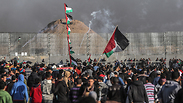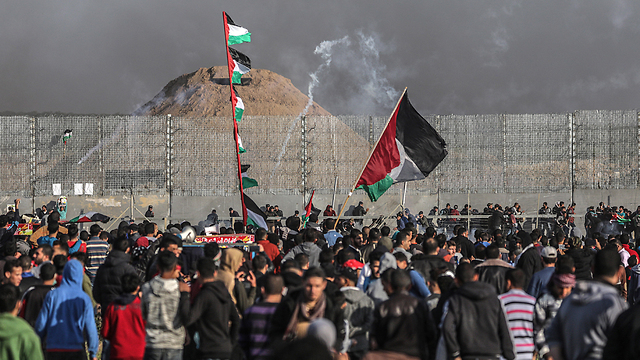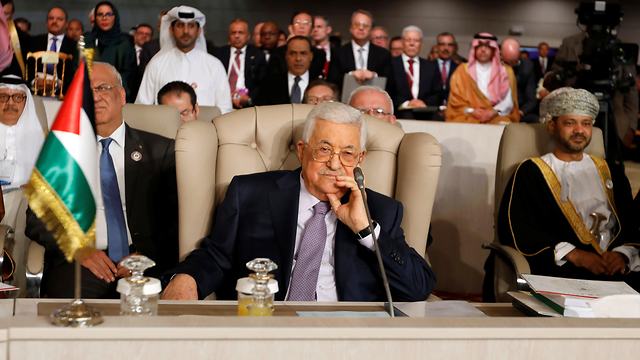
Palestinian leadership too lazy to fight Israeli occupation
Opinion: The reason why March of Return protests haven’t spread beyond the Gaza Strip is Palestinian public’s distrust of the elected officials, which can only be mended by a unified political front in order to resist the occupation in a democratic way
The land is at the heart of the conflict between the Zionist movement and the Palestinian people. This issue has become more important than ever in light of the colonial government effort to Judaize the country: the plan to increase the number of settlers in the West Bank up to a million in the next few years; the dangerous calls by Israeli leaders to annex Area C, which makes up some 60% of the West Bank; and more recently, US President Donald Trump's recognition of Israel's sovereignty over the Golan Heights.
The only reason the West Bank hasn’t been annexed so far is the Palestinian majority living there. This means in case of annexation the government would be forced to either grant Israeli citizenship to all the West Bank residents or resort to mass expulsion of Palestinians from the area (which would result in an actual apartheid state).
In my opinion, the main reason for a lack of appetite for mass protests in the West Bank is the years-long intra-Palestinian split between the rival Fatah and Hamas factions. This ongoing conflict - which is only getting worse - is also the reason why the Land Day is being celebrated in lavish ceremonies in towns like Sakhnin (Arab city in Israel's Northern District), while Palestinian diaspora elsewhere has completely abandoned its political involvement in the region since the Oslo Accords.
In the past, the Palestinian people were united in their call for freedom and the realization of the Right of Return. Over the years, however, the end goal has changed, and since the establishment of the Palestinian Authority, the discourse has switched to forming a Palestinian state based on a "mutually agreed solution" to the refugee problem.
The establishment of the PA greatly undermined the influence of the Palestine Liberation Organization (PLO), which in the past acted as a central and unifying political body, representing not only the residents of the West Bank but Gaza - which is ruled by Hamas - and the Palestinian refugees as well. Furthermore, when the Palestinian National Council - the legislative body of the PLO - convened last year, there were no representatives from the general public.
The new low in the intra-Palestinian conflict is a result of the absence of a political strategy which could be implemented by a joint Palestinian leadership. In addition, unlike the times of the first intifada - when the leadership was also divided - there is no unity among the masses, who back then united around the idea of resisting the occupation.
This eventually leads to a fundamental change when it comes to the general public’s priorities, which now seems to be preoccupied with its owns interests rather than the national ones, which is why the March of Return protests only take place in the Gaza Strip.
Although these protests come at a price, nowadays they are the most effective and realistic tool the Palestinian people have to fight the occupation. The alternative is either a military struggle - which neither side actually wants for their own reasons - or complete submission to the Israeli demands, which includes the recognition of Israel, demilitarization and fulfilment of the Oslo Accords obligations.
There is, however, another option - formulating a political strategy for a joint campaign under a united Palestinian leadership in line with democratic values. Although currently there’s no leadership among the divided Palestinian public that promotes such a plan, a united political front is inevitable.
Another factor to consider is the fact that the PA does not believe in the importance of popular resistance, which is reinforced by the general public’s dissatisfaction with the leadership’s performance, its constant political failures and corruption among the regime’s officials.
A clear expression of the general public’s distrust of the government came on the Land Day, when officials from various Palestinian factions - the PLO, Hamas and Islamic Jihad - called on the people to take to the streets of Ramallah and other West Bank cities. Only around 20 people actually answered the call and came out to protest. This not the first time the public ignored the leadership’s requests and the elected officials must ask themselves why the masses failed to answer their call on such an important day.
The leadership might say the public is “tired and discouraged," but it’s not entirely true. When it comes to the issues relating to the Temple Mount, for instance, the Palestinians come out en masse to express the displeasure with Israel’s policies.
The Palestinian leadership's refusal to do some soul-searching reflects its inability to lead a popular resistance or even its willingness to initiate it in the first place. There is a need for substantial changes, and if the existing leadership is unable to provide them, another political player will eventually step in and fill the vacuum. We can only hope that whoever it might be, will bring new ideas and the Palestinian agenda will not be left behind.












